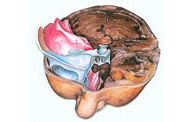Cranial base tumours


Brain surgery via the nose
Endoscopic skull base surgery
What is the skull base?
The base of the skull supports the brain, separating it from the nose and face. The skull base is simultaneously the floor of the brain and roof of the nose.
It is also a part of the body that can be easily accessed. There are many openings in the skull base, of varying sizes, where our main nerves and blood vessels pass through. Tumours that develop in the skull base can be very hard to see; they often hide in crevices or become entwined with vital nerves and blood vessels.
Skull base tumours
Many different types of tumours can develop in the skull base, including meningiomas, pituitary gland tumours, melanomas, carcinomas. Around half of these tumours are benign, with the other half being cancerous.
Treatment for skull base tumours
One of the most significant breakthroughs in the treatment of skull base tumours has been achieved thanks to collaboration between neurosurgeons and otolaryngologists (nasal endoscopists, head and neck surgeons and otologists). This collaboration, which started less than a decade ago, is essential in order to further improve treatment of these tumours which are found in the borders dividing the different areas (brain, nose, ear and throat) and therefore require access from different directions.
This context has led the Teknon Medical Centre to set up the multidisciplinary Skull Base Unit.
Minimally invasive techniques
The use of minimally invasive techniques has led to significant progress in the surgical treatment of skull base tumours.
In the past, operating on these tumours involved making large incisions to the face, as well as the displacement of facial bones, leaving scars and facial disfigurations. They also tended to be very long (10-14 hours), resulting in lengthy and complicated post-operative treatment. Minimally invasive techniques allow us to reduce the patient’s hospital stay by a number of days; usually patients can go home after 24 and 48 hours.
Brain surgery via the nose
Minimally invasive surgery allows us to use endoscopic techniques via the nasal cavity without having to open the skull. It has many benefits compared to traditional surgery, which required open access through the skull or the face. These advantages include a shorter operation time, significantly shorter hospital stays, no facial scarring, considerable improvement of functional results, as well as the possibility of operating on areas that were previously inaccessible. What is more, this kind of surgery can also be performed on large tumours which, until only a few years ago, were considered irremovable.
The optical and endoscopic tools used during surgery via the nose allow for a high-definition visualisation of the area being operated on via fibre-optic stereoscopic cameras. This provides the surgeon with a three-dimensional and full-colour view of the operative field with high-resolution magnified images.
Moreover, the use of brain and facial nerve monitoring devices throughout the operation helps to prevent nerve damage.